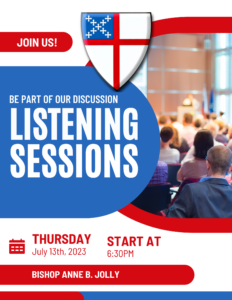
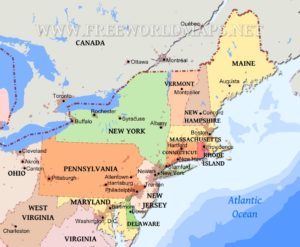 St. John’s Episcopal Church is engaging in an All Parish Fitness Challenge this summer. Help us reach our final destination of Maine, and then get back home stopping to visit other St. John’s Episcopal Churches along the way! You can log your miles on the bulletin board each Sunday, or email them to stjohnohio@gmail.com if that’s easier for you! Follow us on our journey below:
St. John’s Episcopal Church is engaging in an All Parish Fitness Challenge this summer. Help us reach our final destination of Maine, and then get back home stopping to visit other St. John’s Episcopal Churches along the way! You can log your miles on the bulletin board each Sunday, or email them to stjohnohio@gmail.com if that’s easier for you! Follow us on our journey below:
Starting at St. John’s
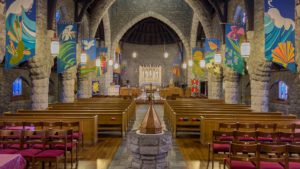
Sunday, June 4th we embarked on a collective journey from our St. John’s Episcopal Church in Youngstown, Ohio and began to log our miles towards our next destination!
Stop 1
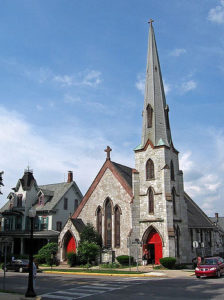
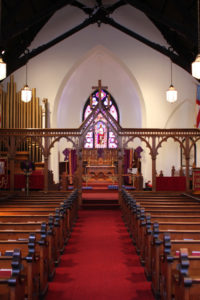 Our first stop was St. John’s in Bellefonte, PA. We reached far beyond this on Sunday, June 11th with a total of 343 miles! This church is a lovely Gothic Revival style built in 1871 and is one of the few churches in its area to still have its original spire!
Our first stop was St. John’s in Bellefonte, PA. We reached far beyond this on Sunday, June 11th with a total of 343 miles! This church is a lovely Gothic Revival style built in 1871 and is one of the few churches in its area to still have its original spire!
Stop 2
 Our second stop was St. John’s Episcopal Church in Yonkers, NY. We reached this on Sunday, June 18th with a total of 136 miles!
Our second stop was St. John’s Episcopal Church in Yonkers, NY. We reached this on Sunday, June 18th with a total of 136 miles!
This church’s exterior is stony like our St. John’s and has a breathtaking roof design. St. John’s in Getty Square was built in 1872. Part of the earlier 1752 Colonial church is preserved and incorporated in the 1872 church, making this St. John’s one of the earliest examples of historic preservation in America.
Stop 3
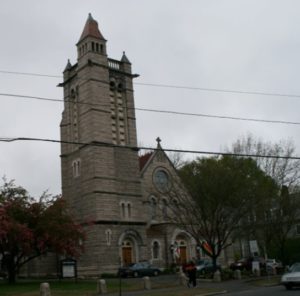
Our third stop is St. John’s in Northampton, Massachusetts!
Completed and consecrated in 1893, St. John’s Northampton is situated on the edge of a college campus – just like our St. John’s! The proximity to Smith College allows St. John’s Northampton to engage in many activities to assist with the college students such as a Midnight Pancake Breakfast during finals week!
Stop 4
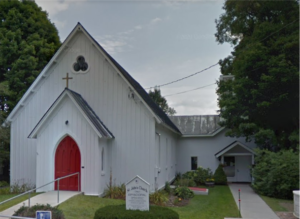 Our fourth stop was St. John’s in Randolph, VT!
Our fourth stop was St. John’s in Randolph, VT!
This quaint little church sits in the center of a neighborhood! Their website has the following information about this church:
For many years there were two Episcopal Churches in Randolph. Grace Church at the Center, and St. John’s in the Village. Both churches trace their ancestry to Christ Church, Bethel, which was organized as a parish in 1794. The first Episcopal service in Randolph was held about 1820 and Grace Church was erected in 1848, fourteen years after the “Episcopal Society in Randolph” was organized.
A complex chain reaction saw St. John’s Randolph grow out of old Grace Church, which was demolished in 1969. St. John’s owes part of its existence to the activities of nineteenth century railroad barons who pushed through a new line in the Civil War era to the town known as West Randolph. Population soon followed and the vestry of Grace Church authorized construction of the present building on Summer Street. (Cost $3,896).
Stop 5
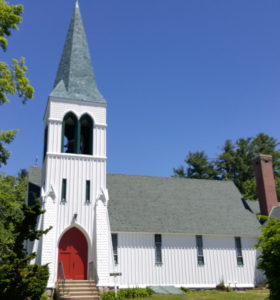
We’ve tallied so many miles this week that we have made it to our weekly destination as well as earned a *bonus* stop in the trip! Our official stop this week landed us in Sanbornville, NH – 143 miles.
St John’s Sanbornville was consecrated in 1877. This gothic style building has over a dozen stained glass windows, many of which are memorials to the family that inspired and funded its construction. St. John’s Sanbornville boasts the only pipe organ in its surrounding area and was a gift to the church in 1924. Restoration work added 122 pipes to the organ in 1992. This church is continuing to grow and saw an addition added in 2021 containing classrooms, offices, and a kitchen to help the local community.
Stop 6: Bonus Stop!
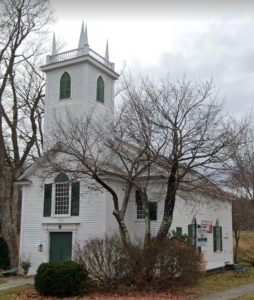
Our *Bonus* stop on the trip is St. John’s in Ashfield, MA.
Another quaint church! St. John’s Ashfield was consecrated in 1828 and was the first parish in the diocese to call a woman priest – Susan Crampton – and the first parish in its diocese to offer a blessing on same-sex couple.
This church holds many artifacts including a wall of photographs depicting every bishop or vicar to serve within its walls since 1828!
Stop 7

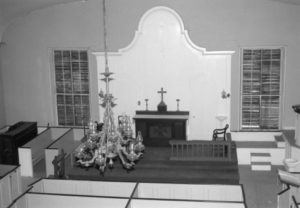 Our stop this week landed us in Dresden, Maine.
Our stop this week landed us in Dresden, Maine.
St. John’s Church in Dresden, Maine is was built in 1832 and dedicated in 1833. It was meant to serve four congregations and was designed as a duplicate of a neighboring church in Pittston.
The original church building blends the architectural styles of Federal and Greek Revival. It’s exterior is a single-story wood-frame structure, with clapboard siding, and a granite foundation. It still has the original louvered shutters and its original box pews.
In 1852 it was dedicated for use exclusively by the Episcopal congregation that was in existence in Dresden since 1770. The church was then named St. John’s Episcopal Church. Gothic Revival elements were added such as an alter and railing, tower spirelets in the balustrade corners, and a Vestry room all set it apart from the Pittston copy.
Currently, this church building is on the National Register of Historic Places and is used for holidays and special events.
Stop 8
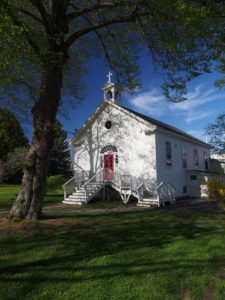
Together we logged over 250 miles and arrived at our final destination before heading back home! This St. John’s is in Southwest Harbor, Maine on Mount Desert Island in Acadia National Park! It is part of a network of churches on Mount Desert Island consisting of five other churches! Below is a photo of the church interior showcasing their 1885 Hook & Hastings tracker organ affectionately called Greta.
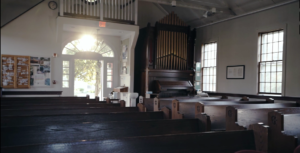
You can view a short video clip of the interior of St. John’s Southwest Harbor, Maine by clicking the following link: Video of St John’s Southwest Harbor, Maine.
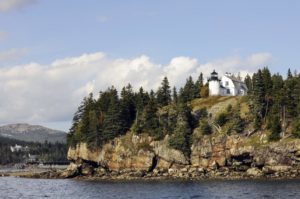 Southwest Harbor, Maine is adjacent to Acadia National Park. This area was chosen due to its beautifully restorative landscapes and quaint small town feeling. Acadia National Park consists of 49,052 acres of land that was donated by private citizens in order to preserve the majestic beauty of this area of the country – just like our Mill Creek Park!
Southwest Harbor, Maine is adjacent to Acadia National Park. This area was chosen due to its beautifully restorative landscapes and quaint small town feeling. Acadia National Park consists of 49,052 acres of land that was donated by private citizens in order to preserve the majestic beauty of this area of the country – just like our Mill Creek Park!
The Acadia National Park welcomes over 2 million visitors every year and it’s stewards work diligently to “nourish and protect the land, ocean, and nature so that the magic will continue.”

We hope you enjoyed this small tour of this area, rest and relax here for a while before we head back home! There are still several more churches to experience on our way back!
Remember to log your miles as you walk, run, bike, or swim for our Parish Fitness Challenge. You can also email your miles to stjohnohio@gmail.com if that is easier for you!
Returning Home: Stop 9
 We asked and you delivered!! Together we logged over 450 miles and arrived at our next destination on our Return Journey!
We asked and you delivered!! Together we logged over 450 miles and arrived at our next destination on our Return Journey!
This week we stay over at St. John’s in Essex, New York! Built in 1835 by Henry Ross, the original purpose of this structure was a school house with the intention to later become a church. St. John’s was incorporated in 1853 and although the church building fell in disrepair and was almost left, the Vestry voted to maintain the building, purchase an adjacent lot in order to create a Parish house and much of the Gothic Revival elements were added to the structure and interior.
For much of the 20th century, St. John’s Essex held worship services as a seasonal church, used occasionally by a shrinking community and vacationers. The church fell into disrepair until the 1980’s when vacationers began retiring to Essex, repairing and endowing the future of the church, and ultimately hiring its first full-time Rector.
St. John’s Essex, New York has changed many times over the nearly 200 years its existed and it’s very inspiring to see all of the wonderful things happening there today.
Returning Home: Stop 10
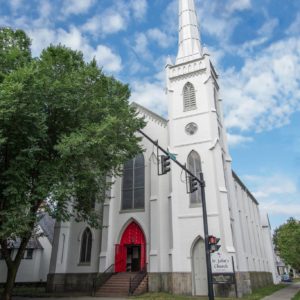 We made it to our next stop in Ithaca, New York!
We made it to our next stop in Ithaca, New York!
Ithaca’s St. John’s Episcopal Society was organized on April 8, 1822 at a meeting held in the Methodist chapel. The original building was consecrated on September 11, 1826 however, after being enlarged in 1855, and a parsonage purchased, the building was torn down and a larger building was constructed in 1860.
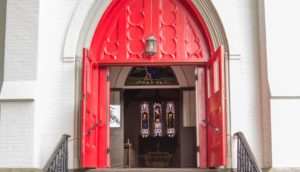
St. John’s in Ithaca, NY and its parishioners have experienced many things over the last 200 years. In the 1960s its parish members supported sit-ins of Cornell and financially supported Black institutions during the Civil Rights Movement.
St. John’s spent their 200 year anniversary compiling histories of its remarkable parishioners including composer Julius Eastman who was in the Boy’s Choir, Connie Cook, an activist who fought for the New York Diocese to allow ordained women to serve the church, and Anna Baker, who saved the church from bankruptcy singlehandedly.
Currently, St. John’s Ithaca works with a non-profit Loaves and Fishes who have recently started a laundromat for those in need in the basement of their church!
Returning Home – Stop 11
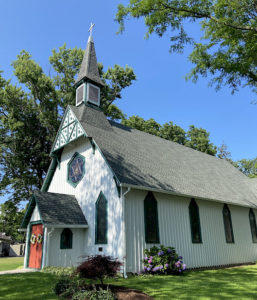
We made it to our next stop in Youngstown, New York!
St. John’s traces its history back to the first Anglican services held in Western New York in 1759 at Fort Niagara!
Formally organized in 1868, the original congregation met in private homes and for a time shared worship space with a Methodist congregation. The present church building was built in 1878 on land donated by Ordnance Sgt. Lewis Leffman.
St. John’s Youngstown, New York was placed on the National Register of Historic Places in 1990. It is only one of a few “carpenter” gothic churches in Western New York with an active congregation. The board and batten siding is original, and the church’s 19 stained glass windows, representative of several eras and styles of church window design, bring light and color into the church. Several of the oldest windows were recently restored, and parishioners have worked hard to ensure that the church is preserved for future generations.
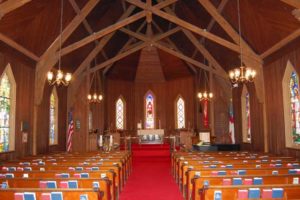
We Made It Home!
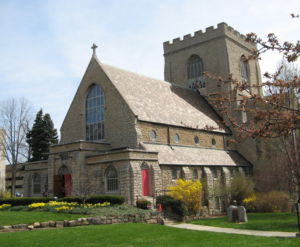


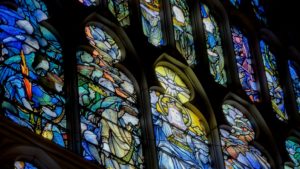
Logging over 2200 miles, we have made it to the coast, up to Maine, nearly to Canada, crossed into 6 different states and arrived safely back home. We visited 11 different churches and learned about their history. All of this would not have been possible without your hard work and dedication to continue to log your miles each week! Thank you all for such a fun summer project to help keep us connected. Glad to be back home and excited to start the new season together!



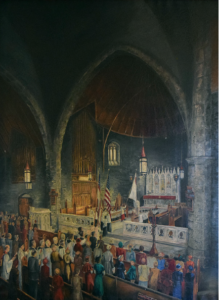
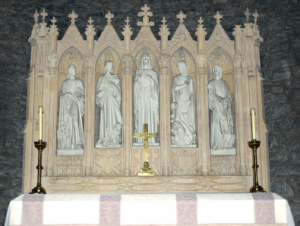
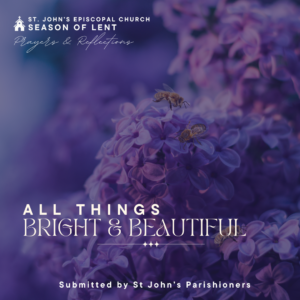
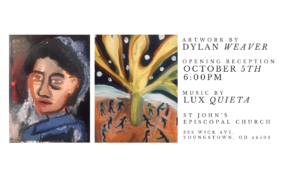
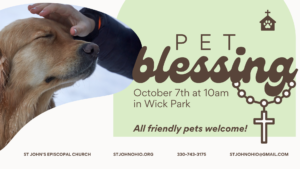
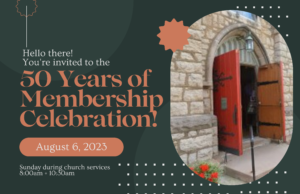

 St. John’s Episcopal Church is engaging in an All Parish Fitness Challenge this summer. Help us reach our final destination of Maine, and then get back home stopping to visit other St. John’s Episcopal Churches along the way! You can log your miles on the bulletin board each Sunday, or email them to stjohnohio@gmail.com if that’s easier for you! Follow us on our journey below:
St. John’s Episcopal Church is engaging in an All Parish Fitness Challenge this summer. Help us reach our final destination of Maine, and then get back home stopping to visit other St. John’s Episcopal Churches along the way! You can log your miles on the bulletin board each Sunday, or email them to stjohnohio@gmail.com if that’s easier for you! Follow us on our journey below:

 Our first stop was St. John’s in Bellefonte, PA. We reached far beyond this on Sunday, June 11th with a total of 343 miles! This church is a lovely Gothic Revival style built in 1871 and is one of the few churches in its area to still have its original spire!
Our first stop was St. John’s in Bellefonte, PA. We reached far beyond this on Sunday, June 11th with a total of 343 miles! This church is a lovely Gothic Revival style built in 1871 and is one of the few churches in its area to still have its original spire! Our second stop was St. John’s Episcopal Church in Yonkers, NY. We reached this on Sunday, June 18th with a total of 136 miles!
Our second stop was St. John’s Episcopal Church in Yonkers, NY. We reached this on Sunday, June 18th with a total of 136 miles!
 Our fourth stop was St. John’s in Randolph, VT!
Our fourth stop was St. John’s in Randolph, VT!


 Our stop this week landed us in Dresden, Maine.
Our stop this week landed us in Dresden, Maine.

 Southwest Harbor, Maine is adjacent to Acadia National Park. This area was chosen due to its beautifully restorative landscapes and quaint small town feeling. Acadia National Park consists of 49,052 acres of land that was donated by private citizens in order to preserve the majestic beauty of this area of the country – just like our Mill Creek Park!
Southwest Harbor, Maine is adjacent to Acadia National Park. This area was chosen due to its beautifully restorative landscapes and quaint small town feeling. Acadia National Park consists of 49,052 acres of land that was donated by private citizens in order to preserve the majestic beauty of this area of the country – just like our Mill Creek Park!
 We asked and you delivered!! Together we logged over 450 miles and arrived at our next destination on our Return Journey!
We asked and you delivered!! Together we logged over 450 miles and arrived at our next destination on our Return Journey! We made it to our next stop in Ithaca, New York!
We made it to our next stop in Ithaca, New York!




